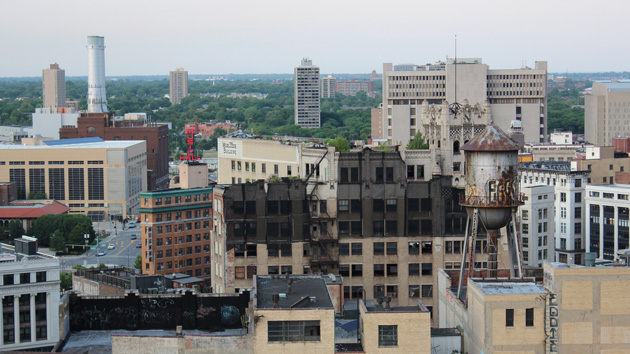Last March, the developers of a restored downtown Detroit apartment building, the Albert, released a promotional video showcasing the swanky amenities that awaited hip millenials if they would just sign a lease and say yes to a city many of their parents and grandparents had left behind. “Detroit is MY generation’s city,” a chirpy twentysomething exclaims as the promo fades to black and the Albert’s sleek graphic reemerges.
If the video was meant to give a behind-the-scenes tour of a building with 127 rental units, it also revealed the mindset of some of the architects of Detroit’s revitalization efforts, who are trying to rebrand the city. The implication of the “my generation” slogan was that the old guard would need to step aside. Indeed, the low-income senior tenants living in the Albert had been informed the previous April that they would need to make other housing arrangements. “There’s all this hubbub about a ‘new Detroit,'” one pushed-out tenant, 58-year-old Recardo Berrien, told Deadline Detroit. “I was born and raised in Detroit. For us not to be part of this ‘new Detroit’ is absurd. We don’t see ‘us’ in none of this. No elderly and poor. We are nowhere in the plans of anyone down here.”
As city leaders—and billionaires—structure Detroit’s future, there has been an emphasis on words like “new,” “revitalization,” “renaissance” and “regrowth,” but very little talk about the systemic issues that led to the city’s decline. The Detroit Future City Strategic Framework, the current blueprint for the revitalization effort, is a 761-page tome that mentions poverty just once and racism not at all. A section of the plan, which Mayor Mike Duggan’s development chief call his “Bible,” calls for a slowdown of city services in high-vacancy areas.
These contradictions are the subject of “H.O.M.E.S.,” the latest song by 30-year-old Detroit hip-hop artist Mic Write, in collaboration with DOSS the Artist, another local rapper. It’s an anthem of city pride that challenges the notion of their town’s corporate revitalization. “My city, my block, my street. Why pity my stock I eat. I read, I learn, I care. I think your data is obsolete. Look, Nigga this that miss me with your savior complex,” he raps in the first verse.
“I used to live in Midtown,” Mic Write told me. “And I was down in Midtown when it was not as bustling as it is now. I was able to see firsthand some of the renewal efforts.” He’s talking about a neighborhood within the 7.2 square miles targeted for redevelopment. “So you kind of learn the terms for it: gentrification, urban renewal. Sometimes you don’t have the terms, you just have a feeling and it goes from, ‘Oh wow, look at all these cool places that I can go to!’ to hearing stories that feel a little bit darker, like about people getting evicted, either formally or just priced out because it was becoming that type of place.”
Mic Write, a 2013 Kresge Foundation Literary Arts fellow and member of a rap collective called Cold Men Young (a play on Coleman Young, Detroit’s first black mayor), explains that he heard stories of friends displaced for the sake of renewal and felt compelled to create something that gets to the heart of the matter. “I don’t mind new things coming in and new lifeblood coming in,” he says. “But I think it’s an issue when there are certain exclusions that come along with it. So I wanted to write an anthem that said, ‘You can come in, but you can’t take what I’m not going to give.'”
So, while the song doesn’t dis the new, it does pay deference to the old. In the accompanying video, the two rappers walk through rich and poor neighborhoods, letting homes of all conditions take the spotlight. “One of the most defining things about Detroit is its homes, or lack thereof,” says DOSS the Artist. “You have this vacant space, this abandoned space. Living here or just spending time touring these different areas of the city, you begin to think, “What is the history? What does it mean for our community for there to be this vacant space where there used to be a life? Where have those people gone? What is left for them?”
Such questions are all too often ignored when civic discussions revolve around blight and the “urban wasteland” instead of the city’s past and the problems that brought about the neglect. Detroit’s history is like a thumbprint; you can ignore the evidence but can’t erase it. The 1967 12th Street Riots, white flight, scandal-ridden city politics, the fading of the Big Three, the subprime fiasco, and the city’s recent bankruptcy all are partly responsible for Detroit’s current state. And while the city is now out of bankruptcy and there’s been a renewed interest from investors in Detroit’s future, “H.O.M.E.S” is a reminder of the people who gave the city its vitality before everyone was obsessed with its re-vitality.
In January, New York magazine ran an article profiling nine Detroit artists and why they chose to live in the city. Pegged to the fact that Brooklyn-based art gallery Galapagos is moving to a warehouse there, the piece argued that Motown was finally having a hip moment, like SoHo in the 1970s. But then, we all know what SoHo’s like now: commercial and sanitized. The issue for Detroit readers was the lack of any connection to the city’s past. And although Detroit’s population is 83 percent black, the article feature exclusively white artists—many of them newcomers.
“H.O.M.E.S was really speaking a lot about the state of Detroit,” DOSS the Artist told me. “Which kind of mimics a lot of the rhetoric around all lives matter and black lives matter right now. This is a space that looks abandoned but it is entirely occupied by people everyday, just performing basic human needs.”
Master photo by Iain Maitland, www.iainmaitland.com
Video shot by Ben Friedman, www.benjamin.strikingly.com













